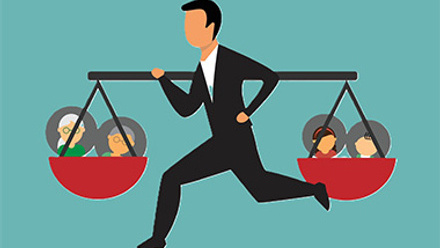4 staff wellbeing ideas to help prevent burnout
The term 'Burnout’ was first introduced in the 1970s by psychologist Herbert Freudenberger to describe the consequences of high expectations and severe stress in ‘helping’ professions. He was referring to those such as doctors and nurses who sacrificed their own wellbeing to care for others.
But burnout is an all too common problem today. It can affect anyone, regardless of their sector or industry, with 40% of the UK workforce affected. But still employers have a hard time identifying this condition because they can confuse it with others.
Burnout – what is it?
Experiencing burnout means exhaustion on all levels. Chronic stress, physical and emotional strain, or working in a demanding job can lead to burnout. When employees burn out, they feel overwhelmed and unable to handle the demands of their jobs.
How to spot burnout
In a study, 68% of UK adults mistakenly identified burnout symptoms as anxiety symptoms. And while anxiety is often a symptom of burnout, there are also more subtle symptoms:
• Detachment
• Cynicism
• Fatigue
• Self-doubt
• Procrastination
• Difficulty concentrating
• Lack of creativity
• Reduced performance
Most of these symptoms are likely to go unnoticed by employers. A sign of burnout is when employees do not deliver work to the standards they usually do. Then again, you might not notice other signs since 16% of employees hide their mental health problems at work.
It is for this reason that prevention is so important. Keeping this in mind, here are four ideas to avoid employee burnout.
1. Reduce stigma
There might be a section on mental health in your employee handbook. You may have mental health cover in your health benefits. But the chances of your employees admitting they’re burning out are slim, unless you openly discuss mental health within your workforce.
You could take advantage of Mental Health Awareness Week, for example, to raise awareness of mental health issues people face.
Alternatively, you could create a channel dedicated to mental health tips and support on your messaging platform. One in four people living in the UK suffer from a mental health issue, according to the NHS. So be realistic about it — when an employee is overwhelmed, it might help them tell you so you can help them.
2. Strengthen connections
Social interaction at the water cooler might be a daily habit for some employees, but this outlet is not available to everyone in the new world of remote and hybrid working.
In fact, 67% say they feel less connected to colleagues while working from home. And burnout only exacerbates this disconnection.
Loneliness and burnout are mutually exclusive, making them difficult to counter. However, both can be prevented.
Set up a wellness channel. Your messaging platform can be used to foster employee wellbeing by creating a channel for tips and support.
Get together regularly. You can offer your team a chance to relax and chat about things other than work during social gatherings (online or on-site).
Maintain an open door policy. Or depending on how you work, you may prefer an open message policy. Give your employees the assurance that they can approach you, or someone within your organisation, if they have a problem.
3. Encourage work boundaries
The habit of saying ‘yes’ too often might lead to burnout for an employee. Another big project may be taken on or they may take on even more responsibilities. Perhaps they feel irreplaceable, or they’re more likely to make themselves invaluable when they think their job is at risk. As a result, they wear themselves out.
Time management tools such as the Eisenhower Matrix can help employees visualise their priorities by ordering tasks according to importance. Additionally, it will encourage them to say no from time to time.
Simple tools such as a shared calendar make it easier for everyone in a team to view an employee's meeting schedule. Additionally, project management tools can help managers keep track of the amount of work staff are assigned and whether they’re able to complete it. Thus, how they are doing can be monitors and support provided if they need it.
4. Promote a healthy work-life balance
According to Deloitte, 51% of employees complete their work outside their contracted hours. Moreover, there’s the culture of leavism, which involves using holiday leave days to get ahead on work. As remote and hybrid working gain popularity, these issues are becoming more difficult to identify.
There are, however, a few clues:
Time off cancelled. Taking time off can seem impossible for employees with large workloads. And employees with specialised skills may feel indispensable.
Working late at night. Your employees may occasionally work late on big projects. But it can be a sign of too much on someone’s plate if they consistently work late to complete tasks.
Clearly fatigued. Anxiety and stress can lead to insomnia, which leads to fatigue. As a result, creativity and productivity suffer.
Anyone can experience burnout. Despite this, sufferers are often unaware of the signs. As a result, employers find it difficult to identify them. Your organisation can benefit from our four ideas for preventing burnout.
Supplied by REBA Associate Member, HealthHero
HealthHero's a digital health provider that brings together human expertise and digital convenience.








